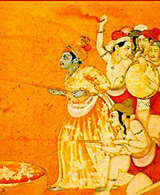|
|
Holi
is a very popular and colorful festival celebrated with more vigor in
North and Central India than in the South. In the South, a similar festival
occurs simultaneously, known as the Kama Festival, celebrated in honor
of Kama, the god of love. Although there seems to be direct link between
the two occasions, both are age-old traditions of celebrating the arrival
of spring.
Holi is celebrated at full moon
in the month of March, corresponding to the month of Phalguna of
the Hindu lunar calendar. Although there exist several stories relating
to the origin of this festival, the following are the two most popular
as told by Hindu folklore.
Kind Hiranyakashipu was a devotee of Shiva and
had received boon of power and wealth. He became obsessed with his
power and claimed sovereignty over the gods. He demanded that his
subjects stop the worship of the other gods, and instead worship
him.
|
 |
He tortured those subjects who did not agree. His own son, Prahalada,
was a staunch devotee of Lord Vishnu even when he was a child. He challenged
his father's claim of sovereignty over the gods and the world. He prayed
to Lord Vishnu, " I want no kingdom, heaven, or freedom from birth. All
I want is an end of the miseries of the people caused by my father."
Hiranyakashipu, realizing his own son to be a potential threat to his
authority, decided to do away with him. When all his efforts to kill Prahalada
failed, the king sought the help of his sister, Holika or Holi, who had
received boon that she could not be killed by the fire. Holika placed
the child in her lap and lit a fire around her in an attempt to burn Prahalada
in fire. However, Lord Vishnu rose from the fire, revoked Holika's boon
burnt her to ashes, and saved the life of His child-devotee Prahalada.
To celebrate this victory of virtue over sin, fire is lit on the eve of
Holi. People collect wood and pile it around a central pole. Sometimes
a pot is filled with seeds and buried under the pole. The pole symbolizes
Prahalada and the wood symbolizes Holika. The pole survives the fire,
whereas the wood is burned to ashes. Some people forecast the success
or the failure of future crops by interpreting the direction of the flames
or the condition of the seeds in the pot buried under the pole. The ashes
from the fire are sometimes collected as protection against diseases and
evil spirits.
Another legend of the Holi festival is that the female demon Pootana,
under orders from King Kamsa, attempted to kill the infant Krishna on
this day by feeding him poisoned milk. In the process, however, Krishna
killed Pootana. To celebrate this event, people enact divine plays that
Krishna enjoyed with the cowherd boys and girls. Therefore, on this day
people of all ages, caste, and classes throw colored water at each other.
Sometimes women beat (lovingly, of course) the men with sticks and the
men must accept this light punishment. People sing and shout, all of which
is intended to symbolize the tricks and pranks played by Krishna on the
gopis (cowherd girls).
 |
Whatever may be the origin of the festival
of Holi, its celebration symbolizes the happiness of the arrival
of the spring season. A long and cold winter can be an emotional
setback. Holi provides hope for a new year with new aspirations.
This may explain the erotic and occasionally curious moods and attitudes
of the people while playing Holi. This is symbolized by people wearing
peacock feathers on their heads, and their clothes and faces stained
with all different colors. |
©
2001 Vandemataram.com All rights reserved.
|
 |